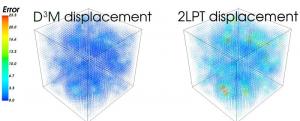AI learns to model our Universe
Researchers have successfully created a model of the Universe using artificial intelligence, reports a new study.

A comparison of the accuracy of two models of the Universe. The new deep learning model (left), dubbed D3M, is much more accurate than an existing analytic method (right) called 2LPT. The colors represent the error in displacement at each point relative to the numerical simulation, which is accurate but much slower than the deep learning model.
Researchers seek to understand our Universe by making model predictions to match observations. Historically, they have been able to model simple or highly simplified physical systems, jokingly dubbed the "spherical cows," with pencils and paper. Later, the arrival of computers enabled them to model complex phenomena with numerical simulations. For example, researchers have programmed supercomputers to simulate the motion of billions of particles through billions of years of cosmic time, a procedure known as the N-body simulations, in order to study how the Universe evolved to what we observe today.
"Now with machine learning, we have developed the first neural network model of the Universe, and demonstrated there's a third route to making predictions, one that combines the merits of both analytic calculation and numerical simulation," said Yin Li, a Postdoctoral Researcher at the Kavli Institute for the Physics and Mathematics of the Universe, University of Tokyo, and jointly the University of California, Berkeley.
At the beginning of our Universe, things were extremely uniform. As time went by, the denser parts grew denser and sparser parts became sparser due to gravity, eventually forming a foam-like structure known as the "cosmic web." To study this structure formation process, researchers have tried many methods, including analytic calculations and numerical simulations. Analytic methods are fast, but fail to produce accurate results for large density fluctuations. On the other hand, numerical (N-body) methods simulate structure formation accurately, but tracking gazillions of particles is costly, even on supercomputers. Thus, to model the Universe, scientists often face the accuracy versus efficiency trade-off.
However, the explosive growth of observational data in quality and quantity calls for methods that excel in both accuracy and efficiency.
To tackle this challenge, a team of researchers from the US, Canada, and Japan, including Li, set their sights on machine learning, a cutting-edge approach to detecting patterns and making predictions. Just as machine learning can transform a young man's portrait into his older self, Li and colleagues asked whether it can also predict how universes evolve based on their early snapshots. They trained a convolutional neural network with simulation data of trillions of cubic light years in volume, and built a deep learning model that was able to mimic the structure formation process. The new model is not only many times more accurate than the analytic methods, but is also much more efficient than the numerical simulations used for its training.
"It has the strengths of both previous [analytic calculation and numerical simulation] methods," said Li.
Li says the power of AI emulation will scale up in the future. N-body simulations are already heavily optimized, and as a first attempt, his team’s AI model still has large room for improvement. Also, more complicated phenomena incur a larger cost on simulation, but not likely so on emulation. Li and his colleagues expect a bigger performance gain from their AI emulator when they move on to including other effects, such as hydrodynamics, into the simulations.
"It won't be long before we can uncover the initial conditions of and the physics encoded in our Universe along this path," he said.
Source: Kavli Institute for the Physics and Mathematics of the Universe (Kavli IPMU)
- 265 reads
Human Rights
Fostering a More Humane World: The 28th Eurasian Economic Summi

Conscience, Hope, and Action: Keys to Global Peace and Sustainability

Ringing FOWPAL’s Peace Bell for the World:Nobel Peace Prize Laureates’ Visions and Actions

Protecting the World’s Cultural Diversity for a Sustainable Future

Puppet Show I International Friendship Day 2020

